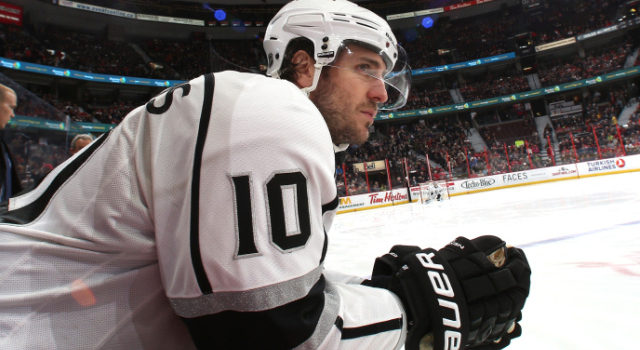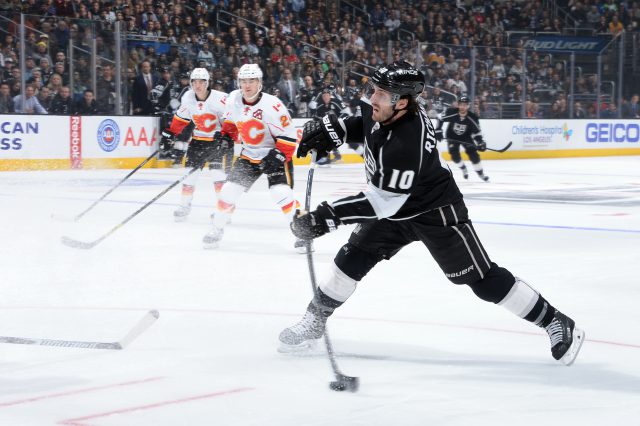MIKE RICHARDS
This season: 53 games, 5 goals, 11 assists, 16 points, 39 penalty minutes, -10 rating, 13:22 time on ice
The good: Through the first month and a half of the season, Mike Richards appeared to perhaps show that he was ready and capable to emerge from a personal down year and elevate himself above the occasional fourth line assignments he drew the previous season (a reminder: he finished fourth among Kings forwards in ice time in 2013-14). He totaled two goals and seven points – three of which came on the power play – over his first 14 games. At the very least, he was more than ably serving in the role he held late in the prior year. Richards was on the ice for only two goals against over a total of 39:00 of shorthanded time, and that’s a very good penalty killing rate, even if he wasn’t used on the PK as much as he had been earlier in his career. His 1.24 points per 60 minutes was in the middle of the pack and ranked above Dustin Brown, Nick Shore and Jake Muzzin. A tenacious and intelligent center, Richards is a consummate teammate who has won at virtually every stop in his career.
The bad: After logging at least 15 minutes in 13 of the first 17 games, Richards cracked 15 minutes only once the rest of the season as his usage dropped to the level of a role player. After the All-Star Break, the two-time Stanley Cup winner was assigned to Manchester after clearing waivers, and he performed reasonably well in the AHL. Recalled 10 days after the club lost Jarret Stoll to an upper-body injury (and after having returned to Los Angeles for fitness testing), Richards joined the team in March on an extended road trip and appeared in five consecutive games, culminating in a team-wide off-night in a 4-1 loss at Chicago. He was scratched in five of the team’s six remaining games, though he was selected to suit up in the vastly important game in Calgary in April – and he earned an assist and a plus-one rating. His five-on-five Corsi-for was a 51.6%, 4.1% below the situations in which he wasn’t on the ice and 1.1% below Nick Shore, who more or less served as his replacement. While he was on the ice, the Kings averaged 29.6 shots against per 60 minutes, the highest rate amongst forwards and second-highest only to Robyn Regehr (though to be fair, only Anze Kopitar and Dustin Brown received tougher zone starts amongst forwards). Though he appeared in only 53 games, his point total was half of any previous season, and his time on ice had dropped by over three and a half minutes from the season prior. “It’s natural for people on the outside to want to have all the answers, but you know what? Mike’s still got lots of game left, and he’s been frustrated with it this year, too,” Darryl Sutter said in January. “I think he’s still got lots of game left, that’s how I feel. I feel the very same way as when Colin Fraser was waived last year – how you feel about those guys because of what they went through. Not just to win championships, but what they went through here in terms of helping get the team back to where it should be in terms of compete and work and all that. That’s how I still see Mike.”
Going forward: Citing loyalty, trust, and the expectations that Richards’ off-season conditioning could evolve for the better, Dean Lombardi chose not to use an available compliance buyout on Richards last summer that would have wiped the 30-year-old’s contract from Los Angeles’ books. “We expect loyalty from our players, and I think it’s a two-way street, and I think under the circumstances, what he had done for us, I thought he deserved a chance to get back to what he knows he was capable of,” Lombardi said in January. Instead, the Kings are now considering a non-compliance buyout as “a possibility,” which represents a shift from mid-season thinking when the team was more reluctant to do so. Any potential buyout would significantly reduce the Kings’ cap space, though Lombardi has said that the priority remains to retain Richards. There’s also the possibility of a trade, though nothing that had been discussed made any sense to the Kings at the time of the trade deadline. The Kings could also save $950,000 by placing Richards in the AHL (because the league’s minimum salary increases to $575K from $550K this season, the Kings would now receive $950K of cap space, not last year’s $925K), though that doesn’t seem like any long-term plan. Or Richards could continue to play for the Kings; even when he struggled earlier in the season, there was still the understanding that the Memorial Cup, Calder Cup and Stanley Cup winner and World Junior and Olympic gold medalist is capable of thriving deep in the spring amongst a group of players with whom he has won two championships. Richards’ attempts to rebound from a difficult 2014-15 season and his status with the Kings will be a central topic through the team’s off-season course and into training camp and the 2015-16 season. It’s a tough situation for both Richards and Kings fans to comprehend, given what the center meant to the 2011-12, 2012-13 and 2013-14 teams, not to mention a thoroughly compelling performance against Vancouver three years ago that represented an instantly visible shift in the club’s postseason attitude and performance. “I don’t think there’s any question we don’t win that first Cup without what he did for this team, and obviously, we don’t win the second one,” Lombardi said. “But there’s still got to be a certain level here that has to get done.”
2014 Richards evaluation
2013 Richards evaluation
2012 Richards evaluation
Player evaluations: #2 MATT GREENE | #3 BRAYDEN MCNABB | #5 JAMIE MCBAIN | #6 JAKE MUZZIN | #7 ANDREJ SEKERA





Rules for Blog Commenting
Repeated violations of the blog rules will result in site bans, commensurate with the nature and number of offenses.
Please flag any comments that violate the site rules for moderation. For immediate problems regarding problematic posts, please email zdooley@lakings.com.